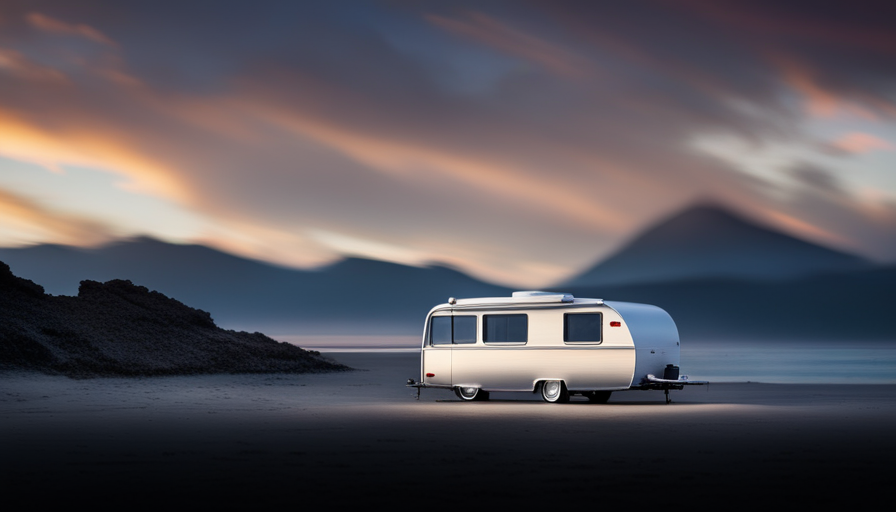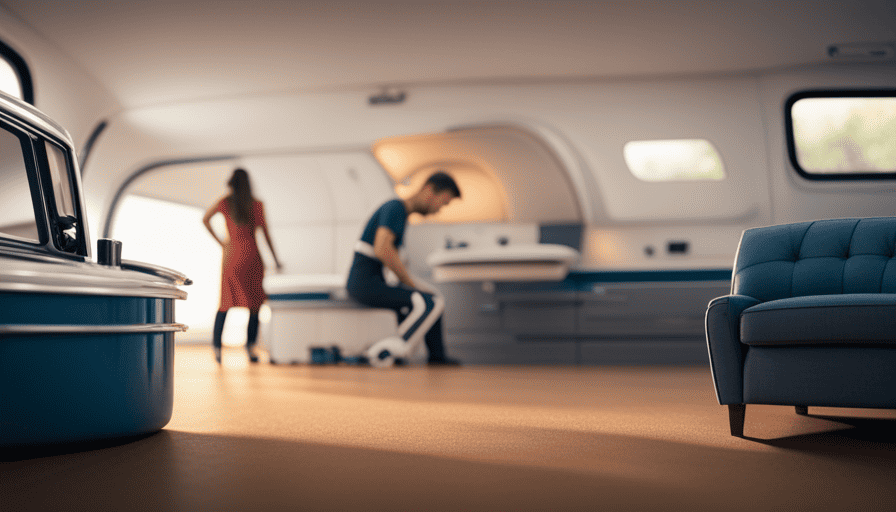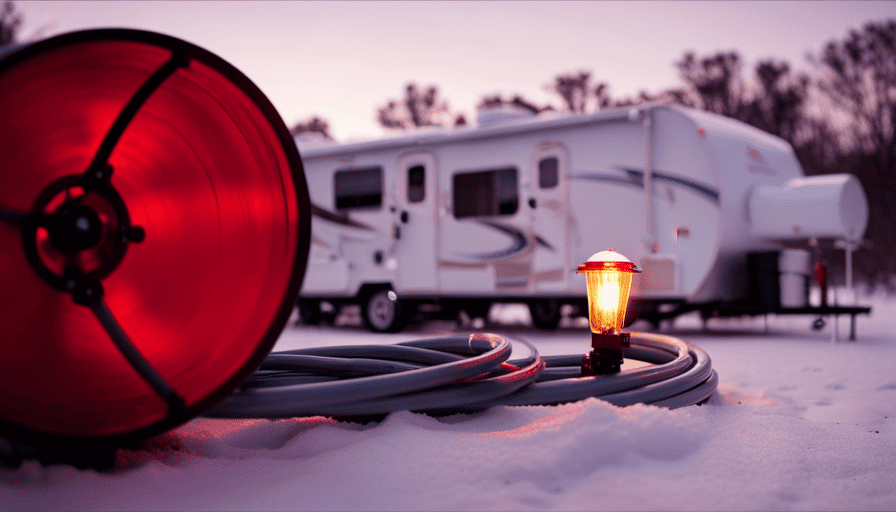Have you ever thought about where all the water you use in your camper goes? Allow me to explain the concept of greywater to you.
Greywater refers to the wastewater generated from various sources inside a camper, excluding the toilet waste. It includes water from sinks, showers, and even laundry activities. Understanding and managing greywater is vital for sustainable camping, as it not only reduces our environmental impact but also conserves a precious resource.
In this article, we will delve into the sources of greywater in a camper and explore the importance of proper greywater management. We will also discuss eco-friendly practices and products for greywater treatment, as well as regulations and guidelines for its disposal in camping areas. Additionally, we will provide tips on minimizing greywater generation in your camper.
So, join us in this informative journey as we uncover the world of greywater in campers and discover how we can make a positive difference for both the environment and our camping experiences.
Key Takeaways
- Greywater refers to wastewater from sinks, showers, and laundry in a camper.
- Proper greywater management is important for sustainable camping and resource conservation.
- Greywater can be disposed of on the ground or collected in a portable holding tank.
- Greywater treatment systems in campers use filters, settling tanks, and biodegradable additives.
Understanding Greywater in Camping
So, you’re wondering what exactly greywater is in your camper, huh? Well, let me break it down for you. Greywater refers to the wastewater generated from various sources in your camper, excluding the toilet waste.
It includes water from your kitchen sink, bathroom sink, and shower. Now, let’s talk about greywater disposal methods and treatment options.
When it comes to disposing of greywater in a camper, there are a few options available. One common method is to release it onto the ground, away from water sources and plants. This method is suitable for dispersed camping or when permitted by local regulations.
Another option is to collect the greywater in a portable holding tank and dispose of it at designated dumping stations. This is a more environmentally responsible approach, ensuring the proper treatment and disposal of the wastewater.
As for greywater treatment options, there are several systems designed specifically for campers. These systems use filters, settling tanks, and sometimes even biodegradable additives to remove impurities and harmful substances from the greywater. They ensure that the water is safe to release or reuse for non-potable purposes.
Now that you understand greywater disposal methods and treatment options, let’s move on to discussing the sources of greywater in a camper.
Sources of Greywater in a Camper
One source of greywater in a camper is when you take the world’s longest shower. Greywater is the wastewater generated from various activities in a camper, such as washing dishes, showering, and washing hands. It contains contaminants such as soap residue, food particles, and dirt.
Proper management of greywater is essential to maintain a clean and sustainable camping environment. Greywater disposal options in a camper include various methods. One option is to collect and store the greywater in a holding tank, which can then be emptied at designated dumping stations. Another option is to use a greywater recycling system that filters and treats the water for reuse, reducing the need for fresh water supply.
Greywater treatment methods can also be employed to ensure safe and eco-friendly disposal. These methods often involve filtration systems that remove impurities and disinfection processes to eliminate harmful bacteria and pathogens. Some advanced systems even use biological processes, such as activated sludge or constructed wetlands, to further purify the greywater.
Proper greywater management is crucial in sustainable camping practices. By implementing effective disposal options and treatment methods, we can minimize the negative impact of greywater on the environment. This ensures a clean and healthy camping experience for everyone while preserving natural resources.
Transitioning to the next section, it is important to understand the role and significance of greywater management in sustainable camping.
Importance of Greywater Management in Sustainable Camping
To truly embrace sustainable camping, you must understand the vital role of managing and conserving your wastewater. Proper greywater management is essential for minimizing environmental impact and ensuring the longevity of your camping experience.
Here are four key reasons why greywater management is crucial:
-
Environmental Protection: Greywater, which includes water from sinks, showers, and laundry, contains contaminants that can harm ecosystems if not properly treated. Implementing greywater filtration systems can remove impurities and prevent pollution of nearby streams, lakes, and vegetation.
-
Resource Conservation: Greywater can be reused for non-potable purposes such as flushing toilets, watering plants, or cleaning. By treating and reusing greywater, you can significantly reduce your freshwater consumption and conserve this precious resource.
-
Health and Hygiene: Untreated greywater can harbor harmful bacteria and pathogens, posing a risk to human health. Implementing appropriate greywater treatment options, such as disinfection methods or constructed wetlands, ensures that the water is safe for reuse and minimizes health hazards.
-
Regulatory Compliance: Many camping sites have regulations in place to protect the environment. Proper greywater management helps you comply with these regulations and demonstrates your commitment to responsible camping practices.
Understanding the importance of greywater management sets the foundation for reusing greywater for environmental conservation, which we will explore in the next section.
Reusing Greywater for Environmental Conservation
If you want to make a positive impact on the environment while camping, consider reusing your wastewater for environmental conservation. Greywater, which refers to the wastewater generated from activities such as washing dishes, clothes, and personal hygiene, can be effectively treated and reused in a camper.
There are various greywater filtration methods and treatment options available to ensure that the water is safe for reuse. One common greywater filtration method is using a physical filter such as a mesh or fabric filter to remove larger particles and debris from the water. This helps prevent clogging and damage to plumbing systems. Another option is using biological filters, which utilize natural processes to break down organic matter and remove contaminants. These filters typically consist of layers of sand, gravel, and plants that help purify the water.
Once the greywater has been filtered and treated, it can be used for various purposes such as flushing toilets, watering plants, or even cleaning outdoor equipment. By reusing greywater, campers can minimize their water consumption and reduce the strain on local water sources.
In the next section, we will explore safe disposal methods for greywater in a camper, ensuring that any residual wastewater is properly managed.
Safe Disposal Methods for Greywater in a Camper
Consider implementing safe disposal methods for your wastewater in order to protect the environment and maintain cleanliness during your camping trip. Properly disposing of greywater is essential to minimize the negative environmental impact caused by its release into the natural surroundings. Here are three safe disposal methods to consider:
-
Burying: Dig a hole at least 200 feet away from any water source, such as a lake or stream. Pour the greywater into the hole, cover it with soil, and mark the location to avoid accidental contact.
-
Filter and drain: Use a portable greywater filtration system to remove contaminants from the water. Once filtered, release the water onto vegetation or the ground, away from any water sources.
-
Use a designated greywater disposal area: Some campgrounds have designated areas where campers can dispose of their greywater. Follow the campground’s guidelines and regulations for proper disposal.
By implementing these safe disposal methods, you can ensure that your greywater doesn’t harm the environment and maintains cleanliness during your camping trip.
In the next section, we’ll discuss greywater recycling systems for campers, which provide an alternative solution for managing greywater.
Greywater Recycling Systems for Campers
Embrace the innovative solution of greywater recycling systems, allowing you to transform waste into a valuable resource while on your camping adventure. Greywater filtration is a key component of these systems, ensuring that harmful contaminants are removed before the water is reused. This process involves passing the greywater through various filters, such as sand, charcoal, and UV disinfection, to remove impurities and pathogens.
The filtered water is then stored in a separate tank, ready for reuse. Greywater storage is an important aspect of greywater recycling systems in campers. These systems typically include a dedicated tank that can hold and store the filtered greywater until it is needed. The storage tank is designed to be compact and lightweight, fitting seamlessly into the limited space of a camper.
By implementing a greywater recycling system in your camper, you can not only reduce your environmental impact but also enjoy the benefits of proper greywater management in campgrounds. These systems promote sustainability by conserving water resources and minimizing the release of pollutants into the environment. Furthermore, they help to maintain the cleanliness and hygiene of campgrounds, ensuring a pleasant and safe experience for all visitors.
Benefits of Proper Greywater Management in Campgrounds
Moving on from discussing Greywater Recycling Systems for Campers, let’s now explore the benefits of proper greywater management in campgrounds. It is essential to understand the advantages of recycling greywater and the techniques for its treatment to ensure a sustainable and eco-friendly camping experience.
One significant benefit of recycling greywater is the conservation of water resources. By reusing wastewater from sinks, showers, and laundry, campgrounds can significantly reduce their freshwater consumption. This not only helps to preserve precious water supplies but also minimizes the strain on local water sources, especially in areas prone to droughts or water scarcity.
Additionally, proper greywater management can contribute to the reduction of pollution. By treating greywater before disposal or reuse, harmful contaminants and pathogens can be removed or neutralized. This protects the environment and prevents the contamination of soil, groundwater, and nearby water bodies.
Various techniques are available for greywater treatment, including filtration, disinfection, and biological processes. These methods effectively remove impurities and ensure that the recycled water meets safety and quality standards.
As we delve deeper into eco-friendly products and practices for greywater treatment, we will discover innovative solutions that further enhance the sustainability of campgrounds while providing a safe and efficient greywater management system.
Eco-Friendly Products and Practices for Greywater Treatment
One way to enhance the sustainability of campgrounds and ensure a safe and efficient treatment of wastewater is by incorporating eco-friendly products and practices into the greywater management system. Greywater recycling and filtration systems are key components of such practices.
Greywater recycling involves collecting and treating the water from sinks, showers, and washing machines for reuse in non-potable applications like irrigation or toilet flushing. This not only reduces the demand for freshwater, but also minimizes the amount of wastewater being discharged into the environment.
To effectively treat greywater, filtration systems are employed. These systems utilize various methods to remove impurities and contaminants from the water, such as sediment filters, activated carbon filters, and UV disinfection. Sediment filters trap larger particles and debris, while activated carbon filters remove organic compounds and odors. UV disinfection uses ultraviolet light to destroy harmful pathogens, ensuring the safety of the recycled water.
In addition to greywater recycling and filtration, other eco-friendly practices can be implemented in greywater management. For instance, using biodegradable soaps and detergents can minimize the impact on the environment. Installing low-flow fixtures and appliances can also reduce the overall water consumption, consequently decreasing the amount of greywater generated.
Transitioning into the subsequent section about regulations and guidelines for greywater disposal in camping areas, it’s important to understand the importance of proper greywater management in order to comply with these regulations and protect the environment.
Regulations and Guidelines for Greywater Disposal in Camping Areas
Ensure that your camping experience leaves behind a pristine natural environment by adhering to the regulations and guidelines for the proper disposal of wastewater in camping areas, preserving the serenity and beauty of the surroundings. When it comes to greywater disposal in camping areas, it’s essential to follow specific regulations and guidelines to minimize the impact on the environment.
Regulations regarding greywater disposal vary depending on the location and the type of camping area. It’s crucial to familiarize yourself with the specific rules and regulations of the area you’re visiting. Some common guidelines include using biodegradable soaps and detergents, avoiding dumping greywater within a certain distance from water sources, and disposing of it in designated areas or facilities.
Additionally, some camping areas may require the use of greywater holding tanks or portable wastewater treatment systems. These systems help to contain and treat greywater before it’s released into the environment, reducing the potential for pollution.
By following these regulations and guidelines, you can ensure that your greywater disposal practices are environmentally responsible.
In the next section, we’ll discuss some tips for minimizing greywater generation in a camper, which further contributes to the preservation of the natural surroundings.
Tips for Minimizing Greywater Generation in a Camper
To minimize the amount of wastewater produced while camping, try implementing these handy tips in your RV.
By minimizing water usage and implementing water conservation techniques, you can significantly reduce the amount of greywater generated in your camper.
Firstly, be mindful of your water usage. Turn off the faucet while brushing your teeth or washing dishes, and limit your shower time. These simple actions can make a big difference in conserving water.
Another tip is to reuse water whenever possible. For example, after washing fruits and vegetables, collect the water in a container and use it to water plants or flush the toilet. This way, you’re making the most out of every drop of water.
Investing in water-efficient appliances can also help minimize greywater generation. Consider installing low-flow faucets and showerheads, as well as a water-saving toilet. These upgrades can significantly reduce water usage without sacrificing comfort.
Furthermore, using eco-friendly cleaning products can also contribute to water conservation. Choose biodegradable soaps and detergents that won’t harm the environment when disposing of greywater.
By following these tips, you can minimize greywater generation in your camper and contribute to a more sustainable camping experience. Remember, every drop counts when it comes to water conservation.
Frequently Asked Questions
How can I safely dispose of greywater in a camper without harming the environment?
To safely dispose of greywater in a camper without harming the environment, we can employ eco-friendly greywater treatment methods. These techniques ensure that the wastewater from sinks, showers, and other sources is properly filtered and treated before being released into the environment.
By utilizing systems such as greywater tanks, filters, and natural treatment processes, we can effectively reduce the impact on the environment and promote sustainable camping practices.
Are there any regulations or guidelines for greywater disposal in camping areas?
Regulations for greywater disposal in camping areas vary depending on the location. It’s important to research and follow the specific guidelines set by the campground or park.
Best practices for greywater management in campers include using biodegradable soaps and detergents, minimizing water usage, and disposing of greywater in designated areas or facilities.
Properly disposing of greywater helps protect the environment and ensures a clean and enjoyable camping experience for everyone.
What are some eco-friendly products and practices for treating greywater in a camper?
Eco-friendly greywater treatment in a camper involves adopting sustainable practices. One option is using biodegradable soaps and detergents to minimize harmful chemicals in the greywater.
Installing a greywater filtration system can help remove impurities before the water is reused or safely disposed of.
Additionally, incorporating a greywater recycling system can enable the reuse of treated greywater for activities like toilet flushing or irrigation, reducing water waste and promoting sustainability.
Can greywater recycling systems be installed in campers?
Greywater recycling technology allows for the installation of efficient and eco-friendly greywater recycling systems in campers. These systems collect, treat, and reuse wastewater from sinks, showers, and washing machines.
The benefits of greywater recycling in campers include reducing water consumption, minimizing environmental impact, and promoting sustainable living. By recycling greywater, campers can conserve water resources and minimize the need for fresh water replenishment, making their camping experience more sustainable and environmentally friendly.
Are there any tips for minimizing greywater generation in a camper?
To minimize water usage in a camper, we can employ various conservation techniques. Firstly, we can install low-flow faucets and showerheads, reducing water flow without sacrificing functionality.
Additionally, using a dishpan or basin for washing dishes can help conserve water. Opting for quick showers and turning off the faucet while brushing teeth are simple habits that can make a significant impact.
Lastly, reusing water for multiple purposes, such as using dishwater to flush the toilet, is another effective way to minimize greywater generation.
How Does Greywater Affect the GVWR of a Camper?
When considering the impact of greywater on the GVWR of a camper, it’s important to understand how the gvwr on a camper explained. Greywater, which consists of used water from sinks, showers, and washing machines, can significantly contribute to the overall weight of the camper. This additional weight could affect the GVWR, which is the maximum weight a camper can safely carry, potentially leading to the need for adjustments or upgrades to ensure safety and compliance.
Conclusion
In conclusion, managing greywater in a camper is crucial for sustainable camping practices. By understanding the sources of greywater and implementing proper disposal methods, we can contribute to environmental conservation.
Reusing greywater allows us to make a positive impact on our surroundings, like a ripple in a calm lake. By using eco-friendly products and following regulations, we can ensure a cleaner campground for future generations.
So let’s minimize our greywater generation and be the guardians of our precious natural resources. Together, we can create a greener and more sustainable camping experience.










